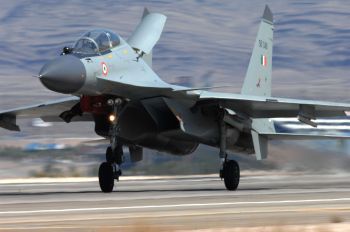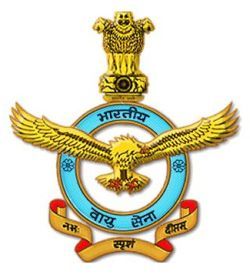
Publisher:
Bonnie King
CONTACT:
Newsroom@Salem-news.com
Advertising:
Adsales@Salem-news.com

~Truth~
~Justice~
~Peace~
TJP
Jan-02-2014 20:12

 TweetFollow @OregonNews
TweetFollow @OregonNews
Indian Air Force: Is it an Expeditionary Force?
Special Commentary by Gp Capt (Retd) PI MuralidharanAfter its experience with four recent Expeditionary Air Missions, considerable debate exists in US military circles on the viability of an expeditionary force in today’s context.
 Indian Air Force Su-30MKI is an air superiority fighter i.e. intended to defeat enemy aircraft in the air and seize control of enemy airspace. bangaloreaviation.com |
(NEW DELHI) - Reporting on the recent assumption of office by the new Chief of the Indian Air Force, The Times of India on 31 December 2013 carried a piece by Rajat Pandit stating that the new Chief would have to focus on faster induction of planned air assets if his force has to eventually become a truly ‘expeditionary aerospace power’ (sic). Whilst this may just be misplaced reportage and not an official policy declaration by the IAF or the government, it needs gainsaying that as per the IAP 2000 IAF Air Power Manual, the IAF does not have an expeditionary role.
Doctrinal Background
 Indian Air Force logo |
Whilst it is true that the IAF now has the assets to function effectively in ‘Out of Area Operations’ (such as Aerial Refuellers, strategic airlifters like the C17s , the AWACS, Special Forces aircraft like the C130 Js and long-range fighters such as the Sukhoi 30s), India’s polity does not expect the IAF to function in an expeditionary role. This is reinforced in the Union War Book and the RM’s Op Directive emanating there from. An Air Expeditionary Force (AEF) - the USAF recently and the Allied Air Forces during WWII would fall under this definition - is one that, in today’s’ context, is capable of deploying a package of ‘shooter’ air power, including air- to-air, precision air-to-ground and defence suppression aircraft into a theatre to begin delivering combat air power within a short period - 48 hours or so. For the USAF, an expeditionary element has been a long felt need, mainly on account of their shrinking overseas basing infrastructure. Thus they look to expeditionary elements to give them a ‘plug- and-play’ 911 policing capability in a theatre in keeping with their strategy of global engagement’. This, in effect, gives them the option, in a contingency, of not having to rely on direct overseas deployment of air power from mainland US. Hence the evolution of their expeditionary air elements to seek to provide rapid, responsive air power tailored to the obtaining geopolitical situation - read ‘adventurism by a rogue nation’ in US parlance - often to give them a ’filler’ capability to overcome naval air power gaps such as absence of an aircraft carrier in the vicinity. The genesis of the USAF Expeditionary Air Force can be traced to Gulf War II around Oct 1994 when Saddam’s forces were threatening to invade Kuwait for a second time a la Gulf War I in 1990, and the USAF had to re -position itself in the region at short call. Later, USAF‘s AEF II deployed to Jordan for several months in 1996. These deployments indeed demonstrated the real ‘speed’ characteristic of air power. Now, the IAF is firstly not geared for a theatre type of military scenario, not still having a CDS nor Theatre Commanders yet. Nor does our country officially advocate functioning like a regional policeman, regardless of what we may have done over the Maldives during Op Cactus Lily or Sri Lanka during Op Pawan, enforcing the writ of the Indian State over a ‘rogue’ neighbouring State.
Out of Area Ops vs. Expedition
So what is the real difference between having Out of Area air capability and being an expeditionary air force? Clearly, it is the prevailing political stance that governs IAF’s operational employment. Like we do not subscribe to employing air power against our own citizens, our country surely would not like to be seen as a regional hegemon that enforces its political will through use of offensive air power, as the US is wont to do globally, especially post 9/11. Also, the USAF sees the AEF as a via media for coalition-building and regional cooperation. The IAF may have carried out a Maldives, a Goa or a Sri Lanka, but an expeditionary military is not in our national psyche. That is not to say that a repeat air action as was done in the cases mentioned is not foreseeable or doable. However, should the Indian government decide in the future to task the IAF with an expeditionary role, the IAF will not only have to buttress its Out Of Area capabilities in terms of further increased inventory in key assets, but more importantly perhaps, exercise the same periodically, to be effective when called upon to do so. There are several aspects to an expeditionary role than just deploying Out of Area. There are airfield management, academic and doctrinal training, flight safety and ground safety, joint exercises etc to be considered. Incidentally, the USAF expeditionary elements do not believe in having ‘full spectrum’ capability, so as not to lose out on staying ‘lean and mean’. This again is an area that would demand rigorous planning and training, were the IAF to assume on an expeditionary avatar.
Other Challenges for an AEF
Another factor in an Air Expeditionary Force deployment is pre-positioning. Whereas the US could facilitate pre-positioning in concerned sectors thanks to their military and foreign policies such as the Status of Forces Agreement (SOFA), what can India do in our vicinity? Would any country in the zone from the Persian Gulf to the Malacca Straits be willing to extend such a facility to us? Prepositioning becomes critical especially for stores such as armament and servicing equipment. An option is to coax friendly neighbours to oblige with similar equipment in their inventory or civil infrastructure/lab facilities, but this would only be wishful thinking in our operational scenario. One gets the uneasy feeling that, possibly with the recent induction of American-origin assets such as the C-130J and the C-17, we have willy-nilly started toying with ideas such as ‘expeditionary’ roles. We have to make a clear distinction and find a balance between our in-country security requirements, from counter-insurgency to anti-terror/anti-hijack operations, wherein our long range assets come into play, and the urge to opt for diplomatic ‘Gun Boat’ options. An expeditionary air force also calls for extensive reorganisation down the command chain, such as setting up Expeditionary Wings and theatre commands. Besides, a high degree of coordination and symbiosis between existing Air Commands and any proposed expeditionary elements would be called for. Another factor that needs consideration in this context is the additional costs involved in such Out of Area Operations. Air lift costs themselves would be considerable for a country like India with its constraints in defence budgeting.
The Roles and Missions Debate
After its experience with four recent Expeditionary Air Missions, considerable debate exists in US military circles on the viability of an expeditionary force in today’s context. Some of their C-in-C s still feel that the capability could be sustained in theatre rather than in mainland US. It would be a folly, therefore, for the IAF not to think through roles such as ‘Expeditionary Air Elements’. We fortunately have a clear definition of our roles and missions (amply articulated to the government through the IAF Doctrine IAP 2000). The IAF does not need to confuse itself with roles which are firstly highly unlikely in our environment and secondly against our national ethos. Similar capabilities could be achieved and maintained without projecting ourselves as an Expeditionary Air Force. It is highly undesirable for any fighting service to be confused about its roles and missions, as military history over the years bears out. It is to be hoped that the reportage mentioned at the beginning of this piece is only an ill-informed aberration and not anything constituting a ‘company policy’ for the IAF.
 |
 |
 |
Articles for January 1, 2014 | Articles for January 2, 2014 | Articles for January 3, 2014
Salem-News.com:





Terms of Service | Privacy Policy
All comments and messages are approved by people and self promotional links or unacceptable comments are denied.
[Return to Top]
©2025 Salem-News.com. All opinions expressed in this article are those of the author and do not necessarily reflect those of Salem-News.com.